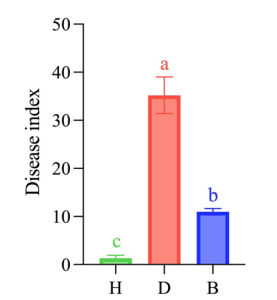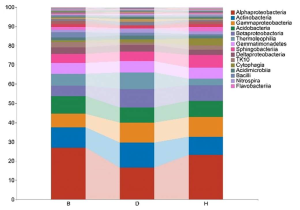A group from Key Laboratory of Microbial Resources Collection and Preservation, Ministry of Agriculture and Rural Affairs, Institute of Agricultural Resources and Regional Planning, Chinese Academy of Agricultural Sciences, Beijing, China, etc. has reported about rhizosphere bacteriome associated with tobacco black shank disease and its biocontrol with Bacillus velezensis S719.
https://www.ncbi.nlm.nih.gov/pmc/articles/PMC10108594/
The tobacco rhizosphere soil samples obtained from the diseased field was regarded as the disease group (D group),
the samples obtained from the healthy control field were regarded as the healthy group (H group), which were 600 m away from the diseased field,
and the biocontrol group (B group) was defined as the diseased field treated with biocontrol agent consisting of Bacillus velezensis S719 after tobacco seedlings were transplanted.
The desease index was the owest in H groups and the highest in D groups as shown below. The effect of Bacillus innocuration was clearly obserbed in B groups comparing with D groups.
The relative abundance of the bacterial taxa was compared at the class levels.
In B groups, Alphaproteobacteria accounted for 27.2% of the ASVs, at least two folds more than other terms in the same group;
In D groups, Actinobacteria was abundant, accounting for 13% of the ASVs, while the proportions in group B and H were 10.6% and 9.5%, respectively;
In H groups, Sphingobacteria and Cytophagia were abundant, accounting for 6.7% and 3.5% of the ASVs, respectively.


